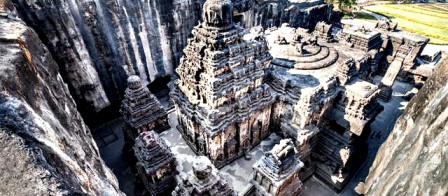Post Mauryan Developments in Culture & Society – History Study Notes & Stuff
These subjects also remain favorites of various examiners. Therefore this article will serve as a good revision tool. Statues of Buddha were carved for the first time in this period of ancient Indian history. Due to contact with foreigners coming from the North West, a distinctly specialized art school known as Gandhar School of Art also developed in this period. This school of sculpture was influenced by Greek and Roman styles / forms of art.
The Stupas:
Originally, a stupa is a large hemispherical dome with a central circular chamber in which the relics of the Buddha or the remains of some prominent Buddhist monks were placed in a small coffin. The base of the stupa was surrounded by a passage to the clockwise circumference / pradakshina. It was surrounded by a wooden railing, which was later carved into stone.
Three major stupas of this period are located at Bharhut and Sanchi in Madhya Pradesh. originally built by Ashoka.
The Bharhut Stupa was in its present form and structure from the middle of the second century BC and has significant sculptures, its railings made of red stone.
In Sanchi, three large stupas were constructed during this period. The largest was originally built by Ashoka and other stupas are located at both Amravati and Nagarjunakonda in Andhra Pradesh.
The Amaravati Stupa, attained its final shape in the second century AD, the sculptures on these stupas are based on the themes of Jataka and other Buddhist stories.
Rock Cut Architecture:
After the post Mauryan period mark progress in rock cut architecture apart from stupas. A large number of temples and halls as well as residence for monks were built in this period. These structures were carved out of solid rocks near Pune and Nashik, which was under to the Satavahanas. The places of worship usually consisted of a shrine cell with a large stupa at the center, this place was known as Chaitya, and the rock cut structure which is used as the residence of the monks was called a vihara.
Schools of Sculptural Art:
The first century saw the division of Buddhism into two separate sects of Hinayana and Mahayana. Mahayana Buddhism then encouraged the worship of Buddha in human form, like God. Thus, a large number of Buddha images were produced in various regions throughout India. There were three major schools for sculpture art and culture, which flourished in this period and these schools are Mathura School of Arts, Amravati School of Arts and Gandhara School of Arts.
The Mathura School of Art:
This major school of art developed in Mathura, UP. The major contribution of the Mathura School to contemporary art was the type of images of the Buddha, which exemplified the art form. Artists from Mathura were using local red stone with black spots to make images of Buddha. The Mathura school also produced ayagapattas (stone slabs) for placing a large number of idols of Jain deities as well as objects of worship on them. Mathura school had a Brahminical influence on art, which is evident in the sculptures. In addition, during the Kushan period, statues of several Brahmin deities like Kartikeya, Vishnu and Kubera were also carved. These show Brahminical influence.
The Gandhara School of Art:
The Gandhar School of Art developed in the vicinity of Peshawar. This school of art was at its peak during the first and second centuries AD. The region witnessed the gradual rule of the Greeks, Mauryas, Sungas, Shakas and Kushans for many centuries. This gave the Gandhara School of Art a different character. Since it began around the Christian era, it is also known as Indo-Greek, Greco-Roman, Graeco-Buddhist art because it has all influences coming from the Roman, Greek and Indian styles.
Saka and Kushan were the chief patrons of Gandhara art. The stones used to make the statue of Buddha and the Bodhisattva were mainly blue-grey schist. The salient features of the Gandhara School of Art are the beautiful depiction of fully human figures with iconic muscles of the body.
In the sculptures, Buddha is depicted with a distinct type of garment draped in Greco-Roman fashion, with curly hair. These beautiful picture are considered the best pieces of sculptures of Buddha.
The Amravati School of Art:
The Amaravati School of Art flourished in the Andhra Pradesh, region situated between the lower valley of the Krishna and Godavari rivers. The major patrons of Amaravati art forms were the Satavahanas of the Deccan and this continued even later.
The art flourished between 150 BC and 350 AD. The sculptures of Amaravati School of Art are mainly located on plinths, railings and different such parts of stupas. The sculptures include themes from the life stories of the Buddha. This is the reason why an important feature of the Amravati school is its 'narrative art'. There are medals carved in a distinctive way that portray an event in a very natural way. For example, one medal depicts an entire story about the naming of an elephant by the Buddha. Another important feature of Amaravati art is the use of white marble to carve the figures of humans. The distinctive emphasis of human figures on nature is a distinctive feature of the Amaravati School of Art.
If you want us to add any more details to this article, please do let us know in the comments below.








0 Comments